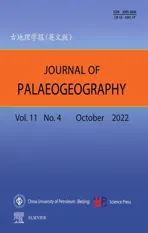Genesis and mechanisms of organic matter enrichment of the Hongshuizhuang Formation in the Zhoukoudian area of Jingxi sag, North China
2022-11-24JinHuZengXioDongLnHoLiuYuShuiWei
Jin-Hu Zeng , Xio-Dong Ln ,*, Ho Liu , Yu-Shui Wei
a School of Ocean Sciences, China University of Geosciences, Beijing 100083, China
b School of Earth Sciences and Resources, China University of Geosciences, Beijing 100083, China
Abstract The Hongshuizhuang Formation is a Meso-Neoproterozoic high-quality source rock in the North China Craton (NCC), comprising abundant organic matter. The present study focuses on the analysis of the Hongshuizhuang Formation in the Zhoukoudian area of the Jingxi sag,discussing its genesis and mechanisms of organic matter enrichment through geological and geochemical methods. The Hongshuizhuang Formation is divided into three members from bottom to top respectively as the lower, middle and upper member. Trace elements analysis indicate that the Hongshuizhuang Formation developed restricted neritic facies in an extensional environment within a continental island arc under a post-orogenic background. The lower and upper members were deposited in a relatively shallow, strongly retained water mass within a suboxic and saline environment influenced by subhumid climate, while the middle member was deposited in an anoxic deep-water environment with relatively low salinity and weak restrictions. The PAAS-normalized rare earth element distributions of the middle and upper members show an enrichment of LREEs and a depletion of HREEs,and a low mean Y/Ho ratio with a positive Eu anomaly,indicating that the regional deposition has been affected by hydrothermal fluids. The negative δ13C and δ18O values and the positive87Sr/86Sr values confirm that the deposition of the middle and upper members was accompanied by crustal hydrothermal activities.Accumulation of organic matter and enrichment of Baxs and P indicate that productivity is the basis of organic matter enrichment in the Hongshuizhuang Formation,where high-quality source rocks are concentrated in the middle member. In addition, reduced water mass controls the preservation of organic matter. Hydrothermal activity,humid climate,and salinity support a higher primary productivity and the formation of reduced water masses. However,due to limitations in depth, the high-quality source rocks in the Jingxi sag are thinner than the Jibei sag.
Keywords Genesis, Organic matter enrichment, Geochemistry, Hydrothermal activity, Zhoukoudian area,Jingxi sag
1. Introduction
Globally, Proterozoic petroleum systems are widely distributed,with large scale discoveries in East Siberia, Oman, the Sichuan Basin of China, northern Australia and western India.Their great potential for developing oil and gas has recently been demonstrated,and became new target areas for deep oil and gas exploration in the world (Wang and Han, 2011;Bhat et al., 2012; Frolov et al., 2015). In the Mesoproterozoic,the number of prokaryotes,mostly algal fungi, increased drastically, and diverse eukaryotes gradually appeared (Sun, 2000; Craig et al., 2013).This development significantly improved marine productivity, providing a solid foundation for the formation of Mesoproterozoic source rocks. The redox conditions of the bottom seawater are also one of the main factors controlling the total organic carbon(TOC).Although there is a controversy concerning the Mesoproterozoic deep-sea environment, it is established that the sedimentary environment is more conducive to the accumulation of high-quality source rocks. Compared with the oxygen-poor and iron-rich seawater in the earlier periods, the oxygen content in the surface layer of the Mesoproterozoic ocean increased considerably and seawater began to be stratified (Canfield, 1998; Poulton et al., 2004; Li et al., 2010). In addition, the influence of hydrothermal activities on organic matter enrichment have received increased attention. Large amounts of inorganic salts carried by hydrothermal fluids will increase the productivity of biota, which not only increase primary productivity, but also enhance anoxia in the sedimentary environment of the bottom of water mass and promote the preservation of organic matter (Zhang et al., 2019). The above studies provide a scientific basis for oil and gas exploration in the Mesoproterozoic.
In the Yanshan area on the northern margin of the NCC,extensive seepage and asphalt is present,out of which 85.2% are distributed in the Meso-Neoproterozoic strata (Wang and Han, 2011). The Hongshuizhuang Formation is one of the main Mesoproterozoic hydrocarbon source rocks in the NCC. Oil seepage has been observed in the Kuancheng area of Hebei Province, with great potential for oil and gas exploration (Luo et al., 2016). However, at present,the tectonic background and depositional supply of the Hongshuizhuang Formation is controversial.Some researchers infer its formation in a back-arc extensional environment,and others support the context of a continental rift (Qiao et al., 2007; Qu et al., 2014;Wang et al.,2015a).The sedimentary environment of the Hongshuizhuang Formation is still inconclusive,varying from carbonate tidal flat facies, lagoon sedimentation, and anoxic-sulfidic environment (Luo et al., 2012; Wang and Luo, 2014; Ma et al., 2017).In addition,there have been few investigations on the hydrocarbon generation potential and mechanisms of organic matter enrichment (Luo et al., 2016; Ma et al., 2017). Therefore, by analyzing the major and trace elements, carbon-oxygen-strontium isotopes,TOC, and rock pyrolysis parameters, this paper aims to delineate the structural background and sedimentary environment of the Hongshuizhuang Formation in the Zhoukoudian area of Jingxi sag.Furthermore,the study highlights regional differences in sedimentary environments and explores the mechanisms of organic matter enrichment.
2. Basic geologic information
The Jingxi sag is located in the Yanshan tectonic belt on the northern margin of the NCC, with the Mihuai uplift in the west, Jidong sag in the east, and Jibei sag in the north (Fig. 1). The Hongshuizhuang Formation is widely distributed in the Yanshan tectonic belt, with a thickness of 38-204 m, thickness increasing towards the NE and reaching a maximum in the Jibei sag. The lithology is relatively uniform,dominated by black shales and dolomites. The underlying rocks belong to Wumishan Formation of the Jixian System, consisting of gray medium-bedded dolomites. The overlying unit is the Tieling Formation, composed of gray fine-grained and microcrystalline dolomites.
In the Zhoukoudian area, the Hongshuizhuang Formation is exposed in the Bajiaozhai section.In this section, the Hongshuizhuang Formation is 39.6 m thick, and the boundaries with the underlying Wumishan Formation and the overlying Tieling Formation are exposed. Based on the lithology, the Hongshuizhuang Formation can be divided into three members.The lower member consists of putty crystal dolomites and powder crystal dolomites with a thickness of 10.7 m.Black shales containing pyrite particles are developed in the middle member,with a thickness of 19.3 m. The upper member mostly consists of powder crystal dolomites and argillaceous dolomites with few pyrite particles.This member has a thickness of 9.6 m(Fig. 2).
3. Sample collection and analysis
In this study,35 fresh rock samples were collected from the Hongshuizhuang Formation of the Bajiaozhai section in Zhoukoudian area of the Jingxi sag,including 22 dolomite samples from the lower member(Fig.3A),7 shale samples from the middle member(Fig.3B),and 3 dolomite samples as well as 3 argillaceous dolomite samples from the upper member (Fig. 3C). The samples were cleaned to remove impurities, dust, and weathered rind on its surface, and the dried samples were ground to microscopic flakes.
The samples were ground to<200 mesh.Major and trace elemental analysis and C-O isotope analysis were completed at the Beijing Research Institute of Uranium Geology. TOC analysis and rock pyrolysis experiments were conducted at the State Key Laboratory of Oil and Gas Resources and Prospecting, China University of Petroleum (Beijing). Sr isotopes were analyzed at the Institute of Earth Sciences, China University of Geosciences (Beijing).
A wave length-dispersive X-ray fluorescence spectrometer is used in major elements analysis and an inductively coupled plasma-mass spectrometry is used in trace elements analysis. TOC analysis was performed using a carbon sulfur analyzer. Rock pyrolysis analysis was performed using an oil and gas display evaluation instrument. For isotopic analysis, δ13C and δ18O values were determined using an isotope ratio mass spectrometer (IRMS) and the analytical results are documented based on the PDB standard.87Sr/86Sr ratios were determined using a thermal ionization mass spectrometer (TIMS) and the standard error of the measured sample was 0.000010.
4. Result
4.1. Elemental analysis
4.1.1. Major elements
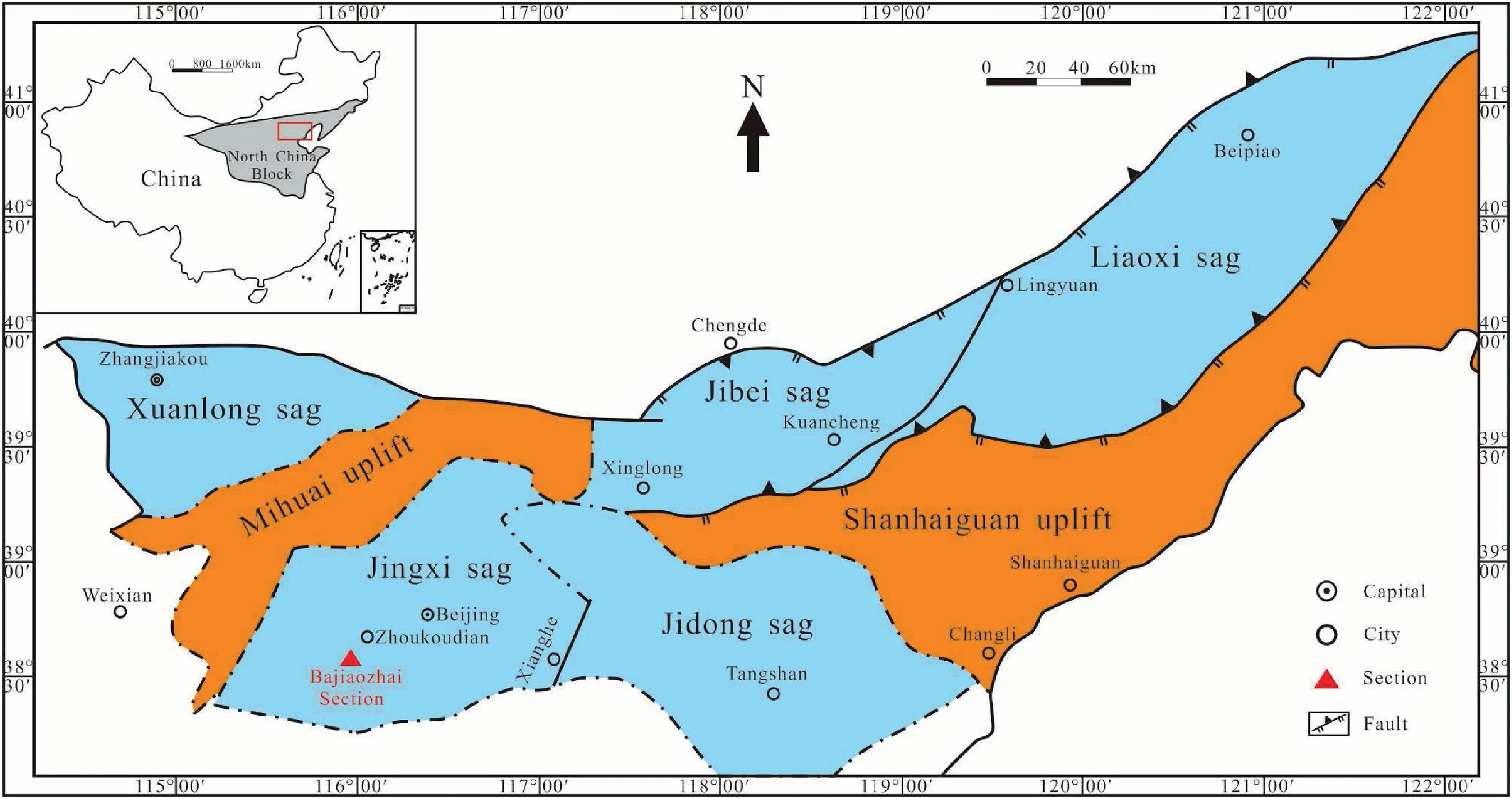
Fig. 1 Tectonic subdivisions of the Yanliao depression and the location of Bajiaozhai section (modified after Luo et al., 2016). The map of China is modified after the Standard Map Service of the National Administration of Surveying,Mapping and Geoinformation of China(http://bzdt.ch.mnr.gov.cn/) (No. GS(2019)1823).
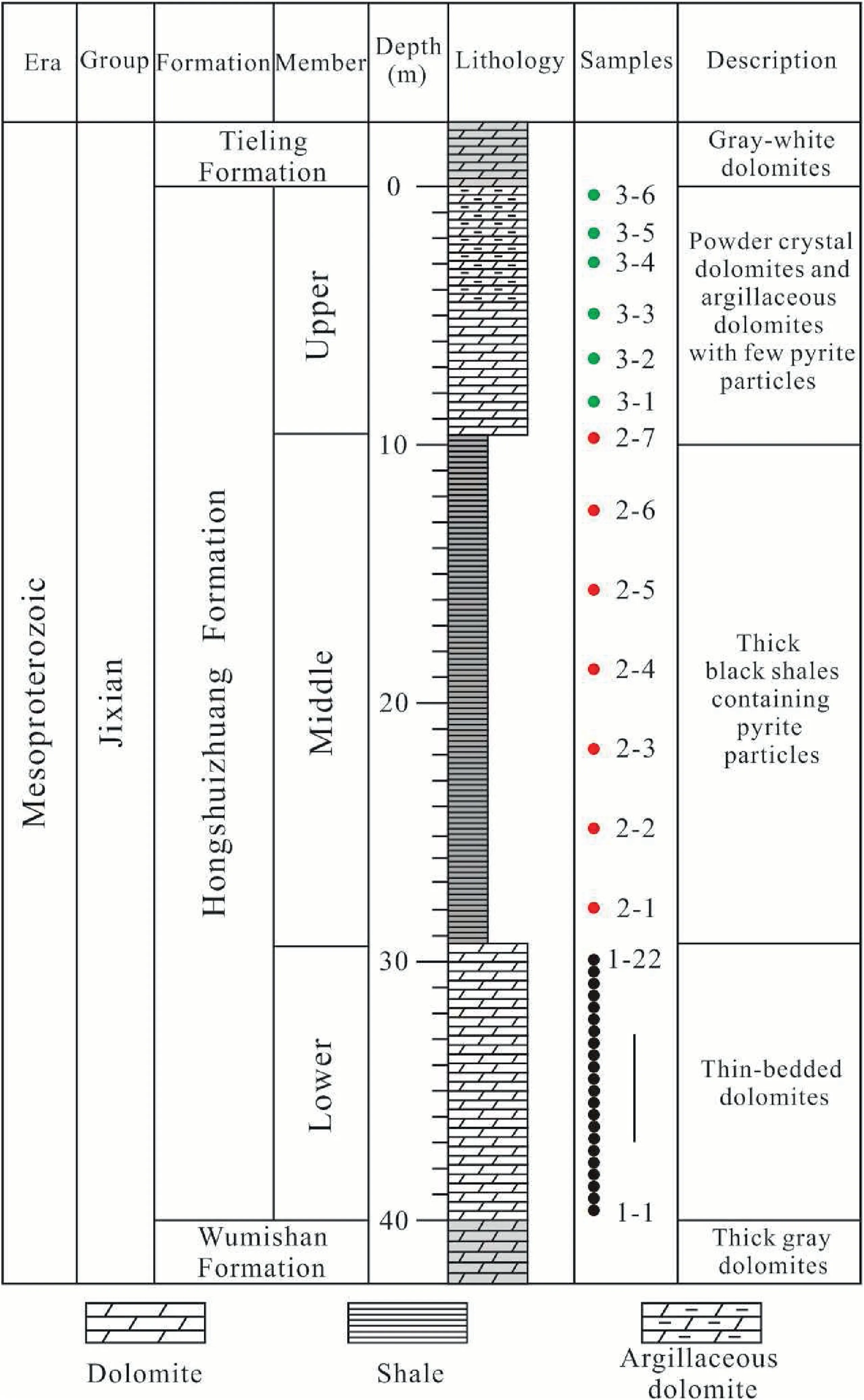
Fig. 2 Stratigraphic column of the Hongshuizhuang Formation in the Bajiaozhai section, Jingxi sag.

Fig. 3 Single polarized light photomicrographs of the Hongshuizhuang Formation from the Bajiaozhai section. A) Dolomite from the lower member; B) Black shale from the middle member; C) Mud-banded dolomite from the upper member.
The analytical results show significant differences in the major elements of the Hongshuizhuang Formation(Table 1).In the lower member,the average SiO2,Al,Na,K,and Ti contents are considerably lower than the average content of the upper continental crust(UCC)(Taylor and McLennan,1985).However,Fe,Mn,and P contents are close to the average content of the UCC, and the average CaO and MgO are considerably higher than the average value of the UCC. In the middle member,the average content of SiO2is slightly lower than the average value of the UCC but higher than the average value of post-Archean Australian shale(PAAS)(Pourmand et al.,2012).The Al,K,Ti,Fe,Mn, and P contents are considerably higher than the average value of the UCC. CaO and MgO are close to those of the UCC, but the Na content is lower. In the upper member, the average content of CaO and MgO are considerably higher and the average content of K and Mn are higher than the UCC.However,the average contents of SiO2,Al,Na,Fe,P,and Ti are considerably lower.
Correlation analysis shows a strong positive correlation of SiO2with Al, K, Na, and Ti (R2= 0.92,R2= 0.94, R2= 0.74, R2= 0.92). Although this correlation is limited to the middle and upper members, it indicates that Si occurs mostly in the lower member as quartz and in the middle and upper members as clay minerals. CaO exhibits a strong positive correlation with MgO(R2=0.99)and a strong negative correlation with SiO2(R2= 0.99). This demonstrates that the CaO and MgO contents are mostly affected by sedimentary minerals such as dolomites and are not related to mafic minerals. A strong positive correlation is evident between P and SiO2, Al, K, Na, and Ti in the upper member (R2= 0.80, R2= 0.84, R2= 0.97, R2= 0.81,R2= 0.93). In addition, Fe and Mn are not correlated with other oxides.
4.1.2. Trace elements
Trace elements show significant stratigraphic differences in the Hongshuizhuang Formation (Table 2).The high field-strength elements (HFSEs) and refractory elements are enriched in the middle member and depleted in the lower and upper members.In the lower and upper members,the average content of HFSEs and refractory elements are considerably lower than in the UCC, such as Sc, Co, Th, Zr, and Hf. However, these elements are enriched in the middle member.
The climate-sensitive elements (Rb, Sr, Cu) and redox-sensitive elements (RSEs: V, Ni, Mo, U, Cr, and Co) strongly fluctuate in the Hongshuizhuang Formation.The Sr content is seriously depleted in the middle member and enriched in the lower and upper members. Rb, Cu, V, Ni, Mo, U, Cr, and Co show opposite characteristics, with high abundance in the middle member and low abundance in the lower and upper members.
Furthermore, the average Ba content in the lower member is only 230.58 ppm, but increases to 1972.71 ppm in the middle member and 930.17 ppm in the upper member.
4.1.3. Rare earth elements
The total REE content significantly varies in the study area, with a peak value obtained in the middle member(Table 3).Among them,the REE content in the lower and upper members are considerably lower than the average value of 146.67 ppm from the UCC. The REE content of shales in the middle member is higher than that of North American shales (160.12 ppm) and PAAS(183.97 ppm)(Mclennan,1989;Pourmand et al.,2012).
Light rare earth elements (LREEs) include La, Ce,Pr, Nd, Sm, and Eu. The heavy rare earth elements(HREEs)include Gd,Tb,Dy,Ho,Er,Tm,Yb,and Lu.The ratio of the LREE to HREE (∑LREE/∑HREE) reflects the degree of differentiation between them. The∑LREE/∑HREE values of the lower,middle,and upper members of the Hongshuizhuang Formation are 4.22,11.62, and 6.67, respectively.
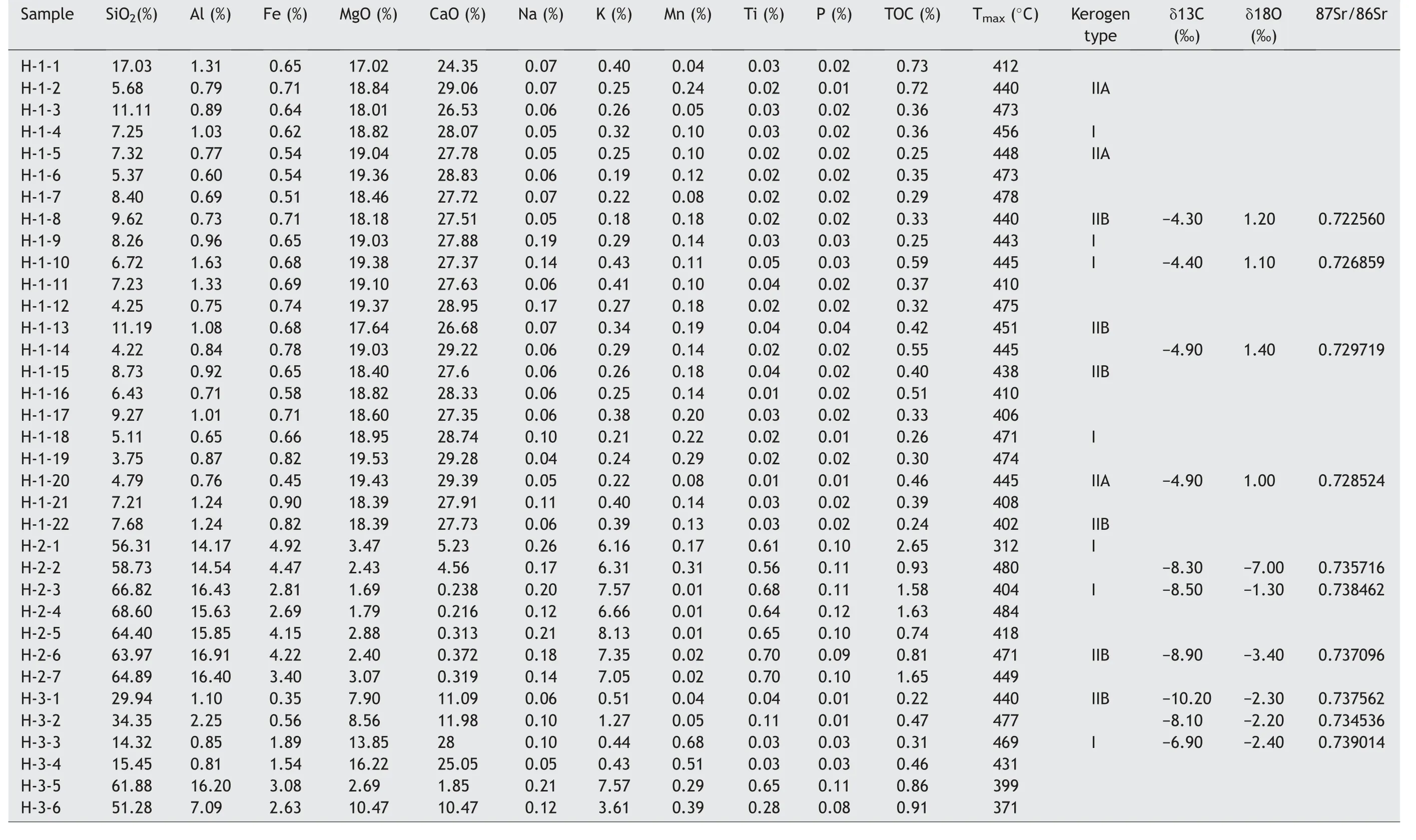
Table 1 The major elements,TOC,rock pyrolysis analysis,and C-O-Sr isotopes of the Hongshuizhuang Formation in the Bajiaozhai section.

Table 2 The trace elements of the Hongshuizhuang Formation in the Bajiaozhai section(unit:ppm).
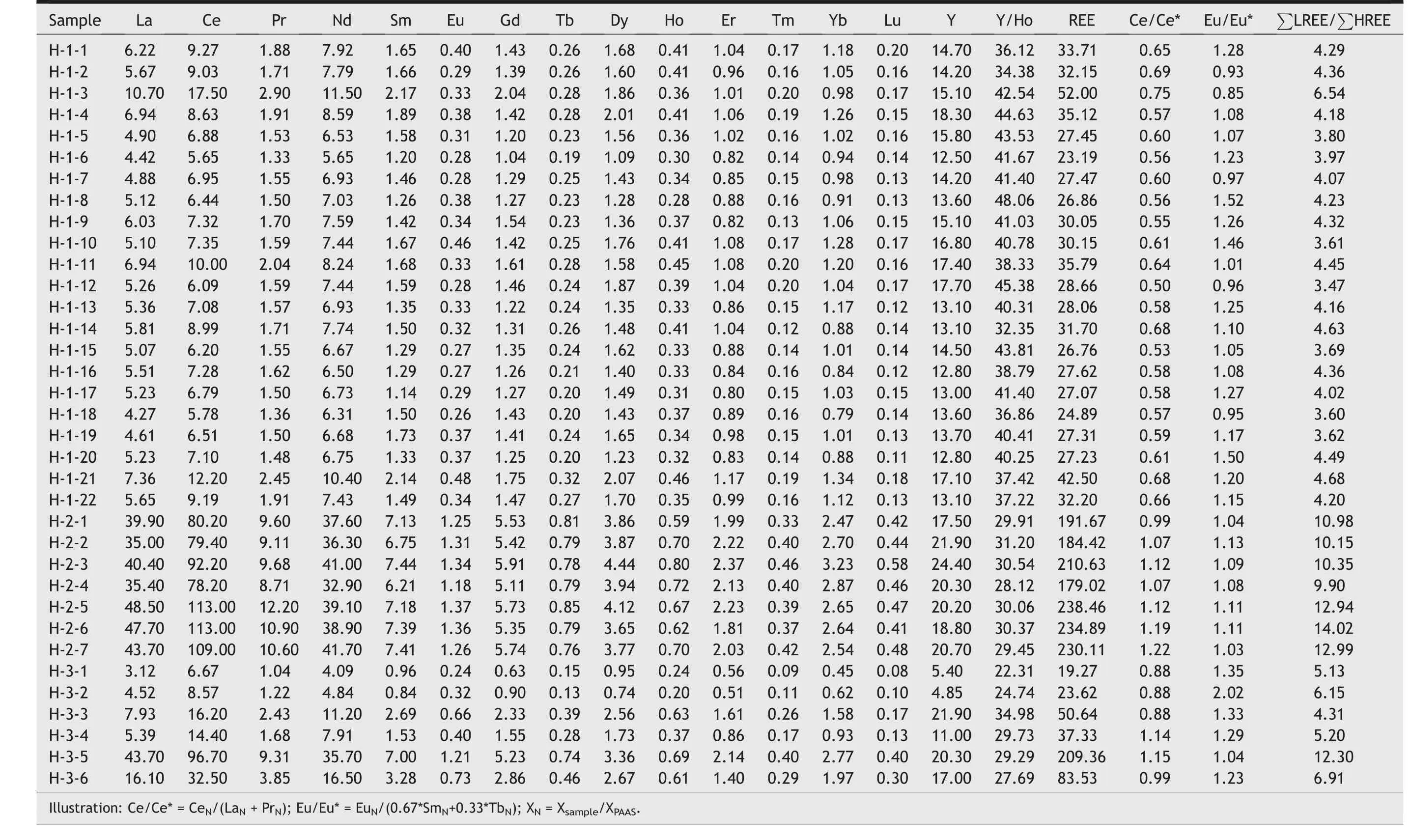
Table 3 The rare earth elements of the Hongshuizhuang Formation in the Bajiaozhai section (unit: ppm).
4.2. TOC and rock pyrolysis
In the Hongshuizhuang Formation,the highest TOC contents are confined principally in the middle member with mostly type-I and type-II kerogens (Table 1).Tmaxvalues of rock pyrolysis range from 402°C to 471°C(mean=441.53°C).Tmaxcan be converted into equivalent vitrinite reflectance(EqVRO=0.018×Tmax-7.16)(Peters and Cassa,1994).Based on this formula,the EqVROvalues of the Hongshuizhuang Formation range from 0.56% to 0.87%.
4.3. C-O-Sr isotopes
The measured δ13C, δ18O and87Sr/86Sr values are different from the lower member to the middle and upper members of the Hongshuizhuang Formation(Table 1). The δ13C and δ18O values of the middle and upper members are significantly lower than that of the lower member. The87Sr/86Sr values display a clear trend of stratigraphic variation with higher values in the middle and upper members compared to the lower members.
5. Discussion
5.1. Provenance characteristics
5.1.1. Sedimentary source
The geochemical composition of clastic sedimentary rocks provides important information for their source regions. Some immobile elements (such as Th,Sc, Co, Hf, and REEs) are considered to have low solubility and mobility. The contents of immobile elements are not easily decreased during sedimentary processes, thus completely preserving the original information of the parent rock(Bhatia and Crook,1986;Armstrong-Altrin et al., 2004; Overare et al., 2020).
Some discrimination diagrams are often used for discriminating the sedimentary source, such as La/Th-Hf diagram (Floyd and Leveridge, 1987), La/Sc-Co/Th diagram (Gu et al., 2002) and La/Yb-REE diagram (Allegre and Minster, 1978). The La/Th-Hf diagram shows a predominant distribution from felsic source in the middle member of the Hongshuizhuang Formation. The La/Sc-Co/Th diagram also reveals contributions from felsic volcanic rock in the middle member of Hongshuizhuang Formation,with low La/Sc ratio and Co/Th ratio.It is noteworthy to mention that the higher the shale content, the more consistent the geochemical characteristics are to the felsic rock in the lower and upper members of Hongshuizhuang Formation. The La/Sc ratio and Co/Th ratio are considerably lower in some dolomite samples with high SiO2content(such as H-3-2)than with low SiO2content(such as H-1-19), and high SiO2content means high shale content for samples from the Hongshuizhuang Formation. This reflects that the terrigenous detrital materials of the Hongshuizhuang Formation originate from felsic volcanic rocks. The La/Yb-REE diagram also supports this viewpoint.The La/Yb ratios and REE are significantly higher in the Hongshuizhuang Formation than in tholeiite (Fig. 4).
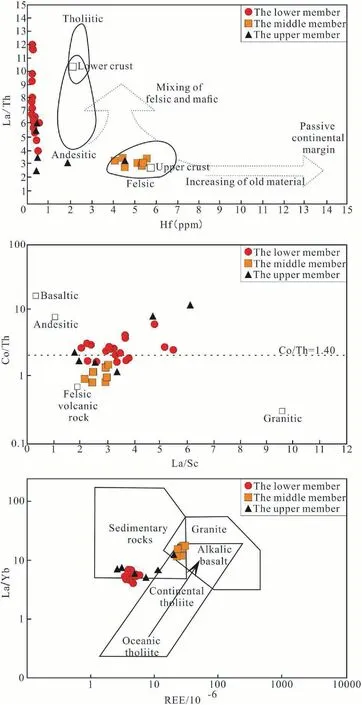
Fig. 4 Hf-La/Th, La/Sc-Co/Th and REE-La/Yb diagrams for sedimentary source of the Hongshuizhuang Formation.
A difference in provenance will also cause a change in the REE. The proportion of LREE increases and the δEu value decreases from basalt to andesite, then to dacite and to granite gneiss in the chondritenormalized REE partition curve (Cullers et al., 1987;Overare et al., 2020). After being standardized by chondrites, the REE partition curves of the Hongshuizhuang Formation exhibit a conspicuous decreasing trend to the right HREEs. The lower member exhibits evident enrichment of LREE, with a(La/Yb)CNvalue of 3.74, and a δEu value of 0.74(Fig. 5A). The fractionation degree of REEs in the middle member is extremely high.The(La/Yb)CNvalue is 10.36,and the δEu value is evidently negative,with an average value of 0.62 (Fig. 5B). In the upper member, although the enrichment degree of LREE decreased, (La/Yb)CNvalue was still as high as 5.51,and the average value of δEu is higher than that in the middle member reaching 0.87 (Fig. 5C). This is consistent with the characteristics of LREE enrichment and HREE depletion in continental provenances, indicating that the terrestrial supply of the Hongshuizhuang Formation is related to granitic rocks from the upper crust.
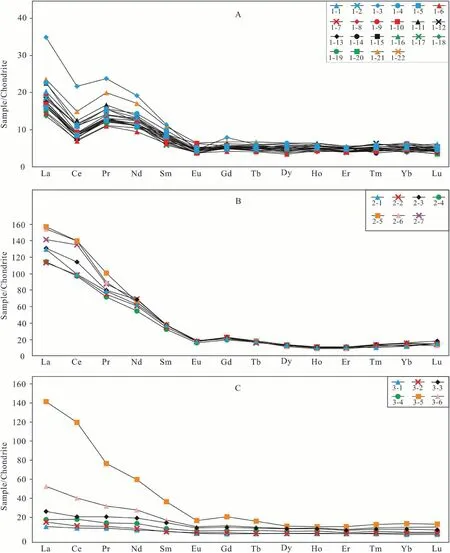
Fig.5 Chondrite-normalized REE distributions in sediments from the Hongshuizhuang Formation:(A)Lower member;(B)Middle member;(C)Upper member.
5.1.2. Tectonic settings
The chemical compositions of clastic rocks are controlled by plate tectonic settings, and consequently clastic rocks from different tectonic settings significantly possess specific geochemical signatures(Bhatia,1985).Inactive elements such as La,Y,Th,Zr,Sc, Co, and Hf, only exhibit a small amount of depletion during weathering,transportation and deposition,and are hardly affected by low-grade metamorphism and diagenesis, which can well preserve the geochemical information of tectonic settings(Periasamy and Venkateshwarlu, 2017).
The La/Sc ratio and La/Y ratio increase continuously from oceanic island arc to continental island arc,and they are highest in active continental margin and passive continental margin, whereas the Ti/Zr ratio,Zr/Hf ratio and Zr/Th ratio decrease continuously(Bhatia and Crook 1986;Lee and Lee,2003).The La/Sc ratios and La/Y ratios are low,and the Ti/Zr ratios,Zr/Hf ratios and Zr/Th ratios are high in the Hongshuizhuang Formation,which are consistent with the characteristics of a continental island arc (Table 4).
The diagrams of La-Th-Sc, Th-Co-Zr/10, and Th-Sc-Zr/10 also indicate that the Hongshuizhuang Formation originates from a continental island arc(Fig. 6).As can be seen from Fig.6,the samples from the middle member plotted in or near the field of continental island arc.When it comes to samples from the lower and upper members of Hongshuizhuang Formation,although only few samples reflect that the tectonic evolution of Yanliao rift was controlled by a continental island arc during deposition of the Hongshuizhuang Formation, other samples show similar geochemical characteristics as the continental island arc.Compared with samples from the upper and lower members, the chemical composition of shales in the middle member is closer to that of the parent rock,which can better preserve the original information of the source region. Thus, we can conclude that the Hongshuizhuang Formation was deposited in an extensional environment within a continental island arc.
Many studies show that at the end of the Paleoproterozoic (1.89 Ga ~1.85 Ga), and the collision of plates led to the constant shrinking of ancient oceanic crust and the formation of the Yanliao rift was probably related to a continental island arc (Hou et al.,2006; Zheng et al., 2009; Zhu and Zheng, 2009; Wang et al., 2015a,b). Combined with previous studies, we believe that the warming and pressurization of the subduction zone between plates led to the melting of lithospheric materials,with the upwelling of magmatic arc. Finally, the continental island arc was developed in the northwest part of ancient NCC. The continuous collision of plates resulted in a local extensional environment behind the continental islands arc, and the Yanliao rift was formed (Fig. 7).
5.2. Depositional environment
5.2.1. Paleoclimate
The influence of the paleoclimate is not only reflected in the sediment input, but also indirectly affects the physical state of the sedimentary water mass(Hakimi et al., 2016; Song et al., 2019; Zhang et al.,2020). Widely used paleoclimate proxies include the Fe/Mn, Mg/Ca, Sr/Ba, Sr/Cu, and Rb/Sr ratios(Lerman, 1978). Fe, Mn, and Ca contents are equally sensitive to salinity and redox conditions, and Ba is affected by productivity. Therefore, Sr/Cu and Rb/Sr values solely affected by climate change are effective indicators for inferring paleoclimatic conditions. In arid climates, the Sr/Cu value is higher than 5.0, and the Rb/Sr value is low. In humid climates, the Sr/Cu value is lower than 5.0, and the Rb/Sr value is higher(Yang et al., 2019).
The mean Sr/Cu of the Hongshuizhuang Formation is lower than 5.0, and the Rb/Sr value is higher,reflecting the overall warm and humid climate of theHongshuizhuang Formation. Several studies support this viewpoint, including paleomagnetic and chemical weathering analysis results. Paleomagnetic results reveal that North China Plate was near the equator for a long time in the Mesoproterozoic(Zhao et al.,1996;Zhang et al., 2000; Wu et al., 2005). Chemical weathering indexes such as CIW and PIW reflect that the source area of the Hongshuizhuang Formation has undergone strong weathering, which could be the result of a warm and humid climate(Luo et al.,2013).In addition, the Sr/Cu and Rb/Sr values changed regularly, indicating that the climate of the Hongshuizhuang Formation fluctuated during the sedimentary period. The low value of Sr/Cu and the high value of Rb/Sr both appear in the middle member,indicating that the climate of the depositional period of Hongshuizhuang Formation changes cyclically.Compared with the upper and lower members, the middle member reflected a more humid climate during its sedimentation (Fig. 8).

Table 4 Geochemical parameters of tectonic setting.

Fig. 6 Th-Sc-Zr/10,Th-Co-Zr/10 and La-Th-Sc diagrams for tectonic setting of the Hongshuizhuang Formation. A: Marine island arc;B: Continental island arc; C: Active continental margin; D: Passive continental margin.
5.2.2. Paleosalinity
Dolomites developed in the lower and upper members of the Hongshuizhuang Formation, whereas shales dominated in the middle member. Although there are several explanations regarding the origin of dolomite, the depositional environment is probably related to high salinity or near high salinity conditions(Compton, 1988; Warren, 2000). The sedimentary environment of shales tends to be a deep low-energy still water environment, and the salinity is generally lower than that of dolomite. The lithological changes are related to the sedimentary environment, reflecting that the seawater experienced a change from high salinity to low salinity and back to high salinity conditions in Zhoukoudian area of the Jingxi sag during deposition of the Hongshuizhuang Formation.
The B/Ga value represents an effective proxy for restoring paleosalinity, which is positively correlated with salinity.In some studies,the B/Ga value of fresh water is lower than 1.2, with 5-6 for brackish water and higher than 7 for marine saline water environment (Deng and Qian, 1993). The V/Zr is another common paleosalinity index.The V/Zr >0.4 indicates marine salt water,0.25-0.4 indicates brackish water,and <0.25 indicates continental fresh water (Wu et al., 2021). In the Hongshuizhuang Formation of Zhoukoudian area, Jingxi sag, the average B/Ga values are higher than 1.2 and the V/Zr values are higher than 0.25, indicating that the deposition of Hongshuizhuang Formation is dominated by seawater.In addition,the average B/Ga values are the lowest in the middle member and have a characteristic of salt water with high salinity in the lower and upper members.The same is the average V/Zr values,which indicates that the salinity of the depositional period of Hongshuizhuang Formation experienced a high--low-high cycle(Fig.8).The salinity in the lower and upper members is higher than normal seawater,whereas the salinity in the middle member is lower and close to that of normal seawater.
5.2.3. Redox conditions
RSEs record the redox conditions of the sedimentary environments (Daniel et al., 2009; Li et al., 2019).Under different conditions,the chemical valence state of RSEs changes significantly,which will appear as highvalence ions under oxidation conditions and be reduced to low valence ions in anoxic water masses (Jones and Manning, 1994; Tao et al., 2016; Li et al., 2020). The oxygen content in seawater can be measured according to the content and ratio of these RSEs.
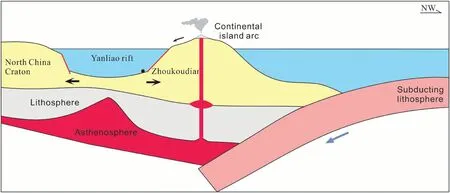
Fig. 7 Schematic illustration of tectonic environment in the Yanliao rift during the deposition of the Hongshuizhuang Formation.
The RSEs all show similar changes in the Hongshuizhuang Formation. The average contents of Fe,Mn,V,Ni,Mo,U,Cr,and Co are the lowest in the lower member and the highest values appear in the middle member(Fig. 9).
The V/Ni and V/(V + Ni) values show that the changes in the sedimentary environment of the Hongshuizhuang Formation follow the trend from suboxic to anoxic and back to suboxic conditions (Fig. 8). In the lower member,the average V/Ni and V/(V+Ni)values are 0.88 and 0.46. The average V/Ni and V/(V + Ni)values are 3.16 and 0.74 in the middle member and are 1.23 and 0.52 in the upper member, respectively.Generally, V/Ni values larger than 3.0 represent a reduced environment, while values between 1.9 and 3.0 reflect hypoxic conditions (Hatch and Leventhal,1992; Rimmer, 2004). V/(V + Ni) values are 0.84-0.89, 0.60-0.84, 0.46-0.60, and <0.46, representing sulfide,anoxic,suboxic,and oxidizing environments, respectively (Arnaboldi and Myers, 2003; Wang et al., 2015a,b). Therefore, it can be inferred that the lower and upper members were mostly deposited in a suboxic environment.In the middle member,with the deepening of water mass and increased stratification,the bottom water was characterized by an anoxic environment. This is consistent with the existence of pyrite in the shales,because pyrites typically develop in reducing environments (Wang et al., 2015b). In addition, although most samples in the upper member reflect a suboxic environment with weak stratification,it deposited in an anoxic condition at times.
The Cu/Zn ratio is a proxy for studying redox conditions, and a low value represents a reducing environment (Nameroff et al., 2002). In the Hongshuizhuang Formation,the average Cu/Zn ratio in the lower member is larger than that in the middle member, which implies that the oxygen content of bottom sea water decreased continuously. The average Cu/Zn ratio increases in the upper member,indicating that the sedimentary environment changed into more oxidizing conditions during later period(Fig. 8).
The formation of a Ce anomaly is typically related to oxidation-reduction. Under natural conditions, Ce primarily exists in two forms: soluble Ce3+and insoluble Ce4+. Anoxic environment leads to the oxidation of Ce3+to Ce4+, causing the Ce to peel off from the water mass and separate from other trivalent REE ions,thereby forming a negative Ce anomaly (Alibo and Nozaki, 1999). A negative Ce anomaly has been found in the lower member of the Hongshuizhuang Formation with an average Ce/Ce*value of 0.61.The average Ce/Ce* values in the middle and upper members are 1.11 and 0.99,respectively(Fig.8).The fluctuations in the Ce/Ce* values reflect the changes in the oxygen content in the bottom water during the sedimentation of the Hongshuizhuang Formation, with the highest oxygen content in the lower member and the lowest in the middle member.
5.2.4. Water mass restriction
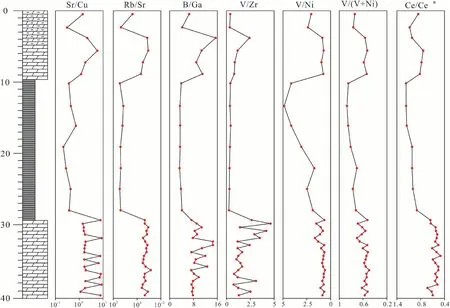
Fig. 8 Stratigraphic variation in Sr/Cu ratios, Rb/Sr ratios, B/Ga ratios, V/Zr ratios, V/Ni ratios, V/(V + Ni) ratios, and Ce/Ce* values.
Mo and U, with similar chemical properties, have long residence times in seawater and show extremely low concentrations in organisms. Therefore, their enrichment in sedimentary rocks can be attributed to autogenous absorption. It is considered effective in analyzing the redox conditions of sedimentary rocks using the covariation relationship among Mo, U, and TOC (Algeo and Tribovillard, 2009; Tribovillard et al.,2012). Generally, in an unrestricted ocean, owing to the good circulation of seawater,the Moautovalues are generally higher than Uautovalues,and there is a strong positive correlation between MoEFand UEF.The change in redox conditions can be discussed through the MoEF-UEFcovariation.However,the MoEF/UEFratios of the Hongshuizhuang Formation vary greatly, and the correlation between MoEFand UEFis extremely poor(R2= 0.34) (Fig. 10). This seemingly contradictory result indicates that during the sedimentation of the Hongshuizhuang Formation, the Jingxi sag was not directly connected with the open sea,but more likely had limited water exchange with the outside deep seawater.Under strongly restricted conditions,Mo and U recharges are low, with an extremely complex enrichment pattern.
These results are supported by the Mo/TOC ratios.The Mo/TOC ratio (unit: ‰) can measure the concentration of Mo in the bottom water during sedimentation. Mo/TOC values are 25-45, 9-25, 4.5-9,and <4.5, representing non-restriction, weak restriction, moderate restriction, and strong restriction,respectively (Algeo et al., 2012; Tribovillard et al.,2012). The average Mo/TOC value of the Hongshuizhuang Formation is only 2.77, and the highest value appears in the middle member. In contrast, the Black Sea is a strongly restricted basin,with almost no bottom water exchange with the Mediterranean Sea,and its Mo/TOC value is 4.5 (Algeo et al., 2012).Considering that the concentration of Mo in Precambrian seawater is lower than that in recent times(Gaschnig et al.,2014;Ye et al.,2021),the Jingxi sag was possibly in moderately restricted setting during the depositional period of the Hongshuizhuang Formation, with the restriction degree being affected by transgression.
5.2.5. Stratigraphic changes and regional differences in the sedimentary environment
The Hongshuizhuang Formation is widely distributed in the Yanshan region in North China.Its thickness increases towards NE, indicating that the water was deep in the northeast and shallow in the southwest during the sedimentation, and the subsidence center was located in Kuancheng area.
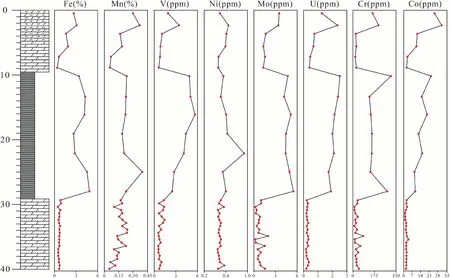
Fig. 9 Stratigraphic variations in RSEs.
During the deposition of the Hongshuizhuang Formation, the study area developed restricted neritic facies, and changed from a moderately restricted environment to a weakly restricted environment and finally back to a moderately restricted environment by climate and transgression. The subhumid climate dominated during the deposition of the lower member,and a shallow and weakly stratified seawater with relatively high salinity and suboxic conditions formed when the regression occurred in the study area,resulting in a moderately restricted environment.During the deposition of the middle member, a more humid climate led to more active river transport and stronger weathering in the source area. The clastic materials from continental island arc were transported to the Jingxi sag through active fluvial processes. In addition,the transgression caused a rise of sea level in the Jingxi sag, disappearance of the carbonate platform and formation a deep-water environment with relatively low salinity and anoxic conditions. Consequently, black shales were developed in the study area.During the deposition of the upper member,the Jingxi sag changed to a moderately restricted environment with salt and suboxic conditions resulted by the subhumid climate and regression, and developed muddy dolomite.
In the Huailai area of Xuanlong sag, the Hongshuizhuang Formation is mostly developed as a carbonate platform lagoon facies, lithologically dominated by gray dolomitic shale and thin-bedded putty crystal dolomite (Luo et al., 2012). The Kuancheng area of Jibei sag included a shallower, oxicsuboxic layer overlying an anoxic-sulfidic deeper layer during deposition of the Hongshuizhuang Formation,with mainly black shale and less dolomite(Luo et al., 2016; Ma et al., 2017). Therefore, we can conclude that the regional differences of sedimentary environment can be attributed to water depth changes.During the deposition of the Hongshuizhuang Formation, the Kuancheng area was located at the subsidence center with the deepest water and mainly deposited black shales. In the Zhoukoudian area, a restricted environment with shallower seawater was reported, while weakly restricted environment only appeared in transgression period. Compared to the Kuancheng area, the oxygen content of bottom water was higher and shale only appeared in the middle member. The Hongshuizhuang Formation was dominated by lagoon sediments with the shallowest seawater in the Huailai area (Fig. 11).
5.3. Mechanism of organic matter enrichment
5.3.1. Paleoproductivity
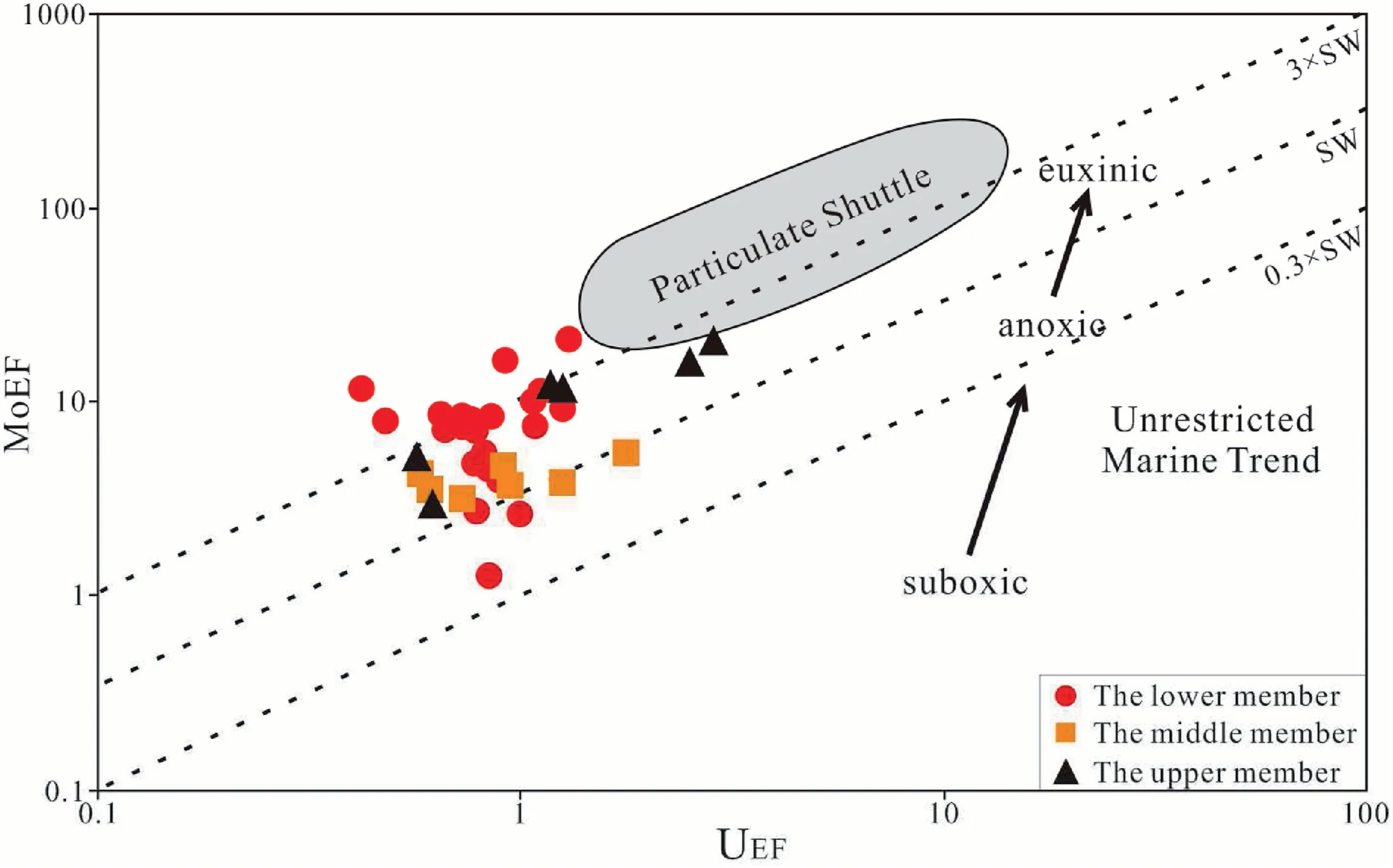
Fig.10 MoEF versus UEF in the Hongshuizhuang Formation.Solid lines show main covariant trends in unrestricted sea,and dotted lines show MoEF/UEF ratios as multiples of the modern seawater value (3 × SW, 1 × SW, 0.3 × SW).
Primary productivity is the fundamental organic matter source and a key to the accumulation of organic matter in sediments (Longman et al., 2019).Previous studies on biomarkers and ancient fossils suggest that different types and large numbers of prokaryotes were distributed in the Yanliao rift during the deposition of the Hongshuizhuang Formation,among which monocular algae and polyhedral algae were dominant (Sun, 2000; Luo et al., 2016). The abundance of prokaryotes,primarily algae,led to the formation of organic-rich shales in the Hongshuizhuang Formation. Biological nutrient elements in sediments, including P, Ba, and Si, can be used as proxies for marine productivity (Tribovillard et al.,2006; Schoepfer et al., 2015). Excluding the sole applicability of silicon to diatom-rich formations,biological phosphorus and biological barium can effectively evaluate the primary productivity of the Hongshuizhuang Formation.
Terrestrial aluminosilicate minerals and biogenic BaSO4are the major contributors of Ba in sediments.In addition, hydrothermal activity produces a certain amount of Ba, which can be ignored in most cases(Dymond et al.,1992).The formula for calculating the biological Ba content is as follows:

In the Hongshuizhuang Formation,the BaXScontent varied significantly. The BaXScontents are extremely low in the lower member, with an average value of 169 ppm. In the middle member, the average BaXScontent is 949 ppm, equivalent to that observed in modern western India(800-1000 ppm),demonstrating medium to high productivity (Babu et al., 2002). The average BaXScontent in the upper member is 622 ppm with a moderate level of productivity (Fig. 12). However, the biogenic BaSO4contained in barite can be consumed by thiobacillus bacteria in suboxic or anoxic environments,likely leading to an under estimation of biogenic Ba content in the Hongshuizhuang Formation(Schoepfer et al., 2015).
P is considered one of the most important nutrient elements in organisms and is the ultimate limiting element for controlling productivity in marine environments. P is also an important component of the skeleton of marine organisms and plays an important role in metabolism (Tyrrell, 1999; Tribovillard et al.,2006). Generally, clastic phosphorus is typically <20%of the total phosphorus,organic matter is the ultimate source of most phosphorus in marine sediments(Schenau et al., 2005; Algeo and Ingall, 2007). The average P content in the lower, middle, and upper members is 203 ppm, 1421 ppm, and 495 ppm,respectively (Fig.12).Among them, the P contents of the middle member are higher than that of the Wufeng and Longmaxi formations in the northern Sichuan Basin(305-829 ppm) and the Changxing Formation of the Xinmin Profile in Guizhou Province (700-1200 ppm),which are considered to exhibit high productivity(Shen et al., 2014; Xiao et al., 2021). The average P content in the upper member is close to the average P value of black shale of the Ubara Profile in Japan(555 ppm), representing a medium-high productivity level (Algeo et al., 2011).
A high TOC indicates a high productivity. The TOC contents partly reflect that the marine productivity in the middle member is higher than that in the lower and upper members. The average TOC contents in the lower and upper members were only 0.37%and 0.54%,respectively, whereas as the average value was much higher in the middle member with 1.43%,representing mudstone with high organic matter (Fig. 12). In summary, BaXS, P, and TOC indicate that the primary productivity of the Hongshuizhuang Formation changed significantly.Compared to the lower member with extremely low productivity and the upper member with medium productivity level, the shales of the middle member were characterized by high productivity and high TOC.
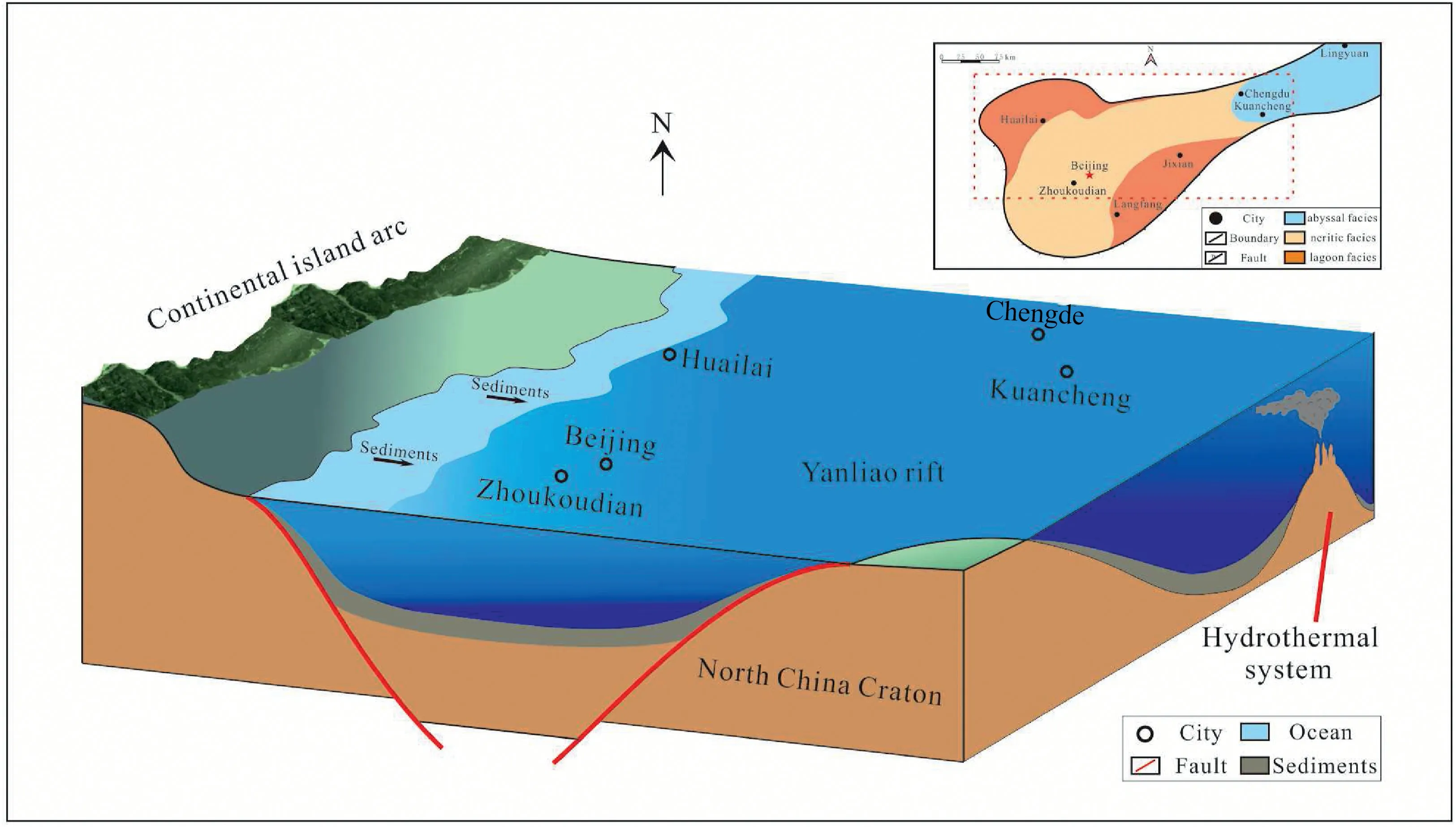
Fig. 11 Schematic illustration of sedimentary environment in the Yanliao rift during the deposition of the Hongshuizhuang Formation.
5.3.2. Evidence of submarine hydrothermal activity
Deep-seated fluids have an important effect on the organic matter enrichment in sediments. On the one hand, volcanic and hydrothermal activities release a variety of nutrients into the water, promoting biological prosperity and improving primary productivity.On the other hand,with the release of sulfide and sulfate such as SO2and H2S in the bottom water,oxygen of the bottom water is continuously consumed, forming an anoxic and even sulfide environment, which is beneficial to the preservation of organic matter.
In hydrothermal systems,REEs in sediments have a unique fractionation mechanism. After the REE concentrations are normalized to PAAS, the REE partition curves of normal marine sediments always exhibit:(1)uniform LREE depletion and HREE enrichment, (2)consistent positive La and negative Ce anomalies, (3)slightly positive Gd anomalies, (4) the average Y/Ho value is approximately 60 (Webb and Kamber, 2000).Sediments affected by hydrothermal fluid can be identified by the enrichment of LREEs and a positive Eu anomaly, with a low Y/Ho value (She et al., 2018).After being normalized to PAAS, the enrichment degree of HREEs is greater than that of LREEs in the lower member, with positive La anomalies, negative Ce anomalies,and positive Eu anomalies.In addition,the Y/Ho ratio is 40.34,which is almost consistent with the characteristics of normal marine sediments.However,in the middle and upper members,LREEs are enriched,with Y/Ho ratios of 29.95 and 28.84, respectively. Ce exhibits a slightly positive anomaly or almost no anomaly, and Eu exhibits a conspicuously positive anomaly (Fig. 13). The PAAS-normalized REE distributions indicate that hydrothermal activity affected the REE composition of the Hongshuizhuang Formation in the Jingxi sag and proves that hydrothermal activity occurred at the Yanliao rift during deposition of the middle and upper members of the Hongshuizhuang Formation.
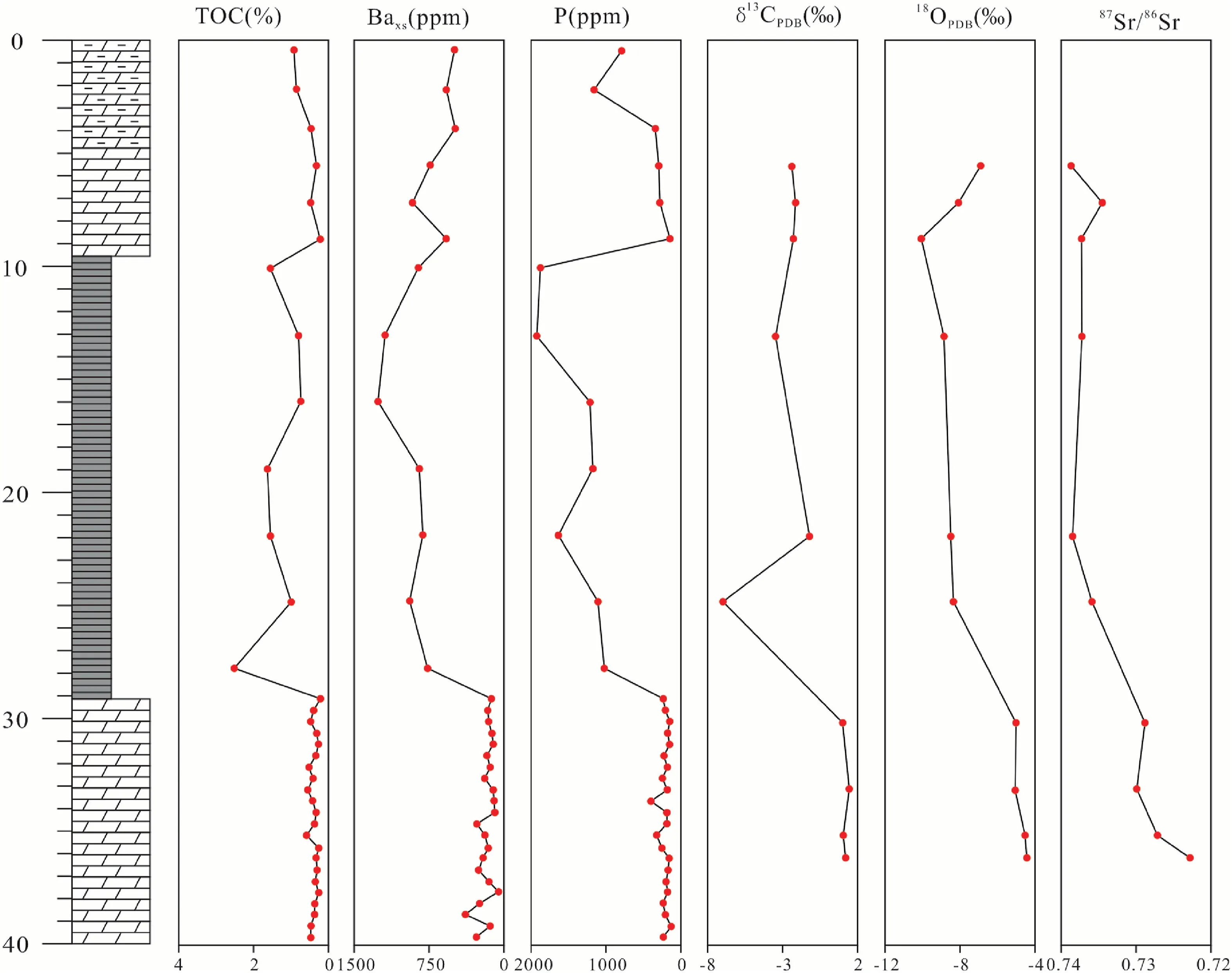
Fig. 12 Stratigraphic variation in TOC content, BaXS, P content, δ13C values, δ18O values and 87Sr/86Sr values.
The negative deviation of the carbon-oxygen isotopes in the Hongshuizhuang Formation can also explain the deep-seated fluid activity. The carbon isotopes of the Hongshuizhuang Formation vary greatly, and the average δ13C value is in the range of normal marine carbonate rocks(0-2‰).However,the average δ13C values of the middle and upper members exhibit a large negative deviation and the migration range can reach 8‰ (Fig. 12). Three conditions will lead to negative carbon isotope deviation of sedimentary rocks: (1) rapid accumulation of organic carbon(Chen and Benton,2012);(2)the entry of volcanic gas and hydrothermal fluids (Huck et al., 2013; Chen et al., 2014; Zhou et al., 2015); and (3) rising sea level. However, the sea level did not rise during the deposition of the upper member, and the influence of rising sea level on δ13C is rather limited, making it impossible to form a significantly negative deviation of δ13C in the middle and upper members. The rapid accumulation of organic carbon is likely to be one of the factors contributing to the negative δ13C bias.Nevertheless,the change in δ13C was inconsistent with the change in TOC.In addition,the upper member with lower productivity and TOC exhibited a similarly negative bias. A more reasonable explanation is that volcanic and hydrothermal activity produces light volcanic gas and hydrothermal fluids, and a large amount of gas and fluids with13C depletion entered seawater and is preserved in sedimentary rocks. The variation in δ18O was almost the same as that of δ13C.The δ18O values were positive in the lower member and evidently negative in the middle and upper members,with an offset of 3.4‰ (Fig. 12). The influence of atmospheric precipitation, glacial melt water, and the flow of submarine hydrothermal activity can cause a decrease in18O in sedimentary rocks(Tan et al.,2004).However, the average δ18O in freshwater is only -4‰(Lan et al., 2016), which is considerably higher than the average values of the middle and upper members.In addition, the upper member was deposited in a hotter and drier environment with less fresh water influx, but its δ18O also exhibits an evidently negative bias.The above evidence indicates that the change in δ18O could be related to submarine hydrothermal activity, and the inorganic materials carried by hydrothermal activity and the high-temperature environment led to the loss of18O.

Fig. 13 PAAS-normalized REE distributions in sediments from the Hongshuizhuang Formation. A) Lower member; B) Middle member; C)Upper member.
Sr isotopes can trace fluid sources in sediments.The fluid from the mantle,modern seawater,river,and crust exhibits an average87Sr/86Sr of 0.70350,0.709176, 0.7136, and 0.721, respectively (All`egre et al.,2010).The average87Sr/86Sr values of different members of the Hongshuizhuang Formation are 0.726915, 0.737092, and 0.737037, respectively,which are considerably higher than the average value of the crustal source (Fig. 12). Notably, the87Sr/86Sr ratios of sedimentary rocks vary with geological time.However, compared with the lower member, the87Sr/86Sr values in the middle and upper members increased significantly, and the ratio was almost the same. This indicates that the contribution of crustal materials in the middle and upper members is considerably higher than in the lower segment. The tectonic setting and sedimentary environment of the Hongshuizhuang Formation have not changed on a large scale, and the massive injection of Sr from the crust can only be attained by submarine hydrothermal fluid from the crust. In other words, a positive deviation of87Sr/86Sr values in the middle and upper members of the Hongshuizhuang Formation comes from submarine hydrothermal activity.

Fig.14 Organic matter enrichment mechanisms of the Hongshuizhuang Formation.A)Lower member;B)Middle member;C)Upper member.
Furthermore, low Mo content and moderate δ98Mo was observed in the Hongshuizhuang Formation,which was interpreted as the removal of light Mo by some redox sinks in the intermediate redox environments(Ye et al., 2021). It may be related to hydrothermal activity,because hydrothermal activity will lead to the massive release of Fe and Mn, then removing95Mo.Therefore,we believe that the Jingxi sag was affected by hydrothermal activity from the crust during the deposition of the middle and upper members,which is likely related to the paleogeographic environment in the Yanliao rift. In the Meso-Neoproterozoic, the North China Plate experienced multiple rift events and magmatic events, with frequent volcanic and hydrothermal activities (Qiao and Gao, 2007; Zhai et al.,2014). Among them, the oldest ocean black smoker has been found in the Mesoproterozoic sulfide deposits near Chengde in the northern NCC (Li et al., 2003).This is considered one of the markers of frequent hydrothermal activity on the Mesoproterozoic seafloor.In the Mesoproterozoic, the asthenospheric mantle plume and local lithospheric mantle plume triggered large scale and long-term magmatic activity in the NCC(Zhu and Zheng, 2009). During the deposition of the middle and upper members of the Hongshuizhuang Formation, the upwelling of magma caused a large amount of hydrothermal material to deposit in the Jingxi sag, thereby affecting the sedimentary and biological environment.
5.3.3. Main factors controlling organic matter enrichment
Organic matter enrichment in the Hongshuizhuang Formation, especially in the middle member, reflect the interaction of multiple factors. High productivity and anoxic conditions of the bottom water are the main factors controlling organic matter enrichment,while paleoclimate, paleosalinity, and hydrothermal activity promoted this process (Fig. 14).
During deposition of the middle member of Hongshuizhuang Formation, a warm and humid climate not only provided suitable conditions for the growth and reproduction of organisms, but also caused the strong weathering in the source area. The biological nutrients components produced by chemical weathering were transported to the Jingxi sag through active fluvial action,thus promoting the development of organisms and improving primary productivity.Hydrothermal activity not only promotes the development of primary productivity, but also contributes to the construction of a reducing environment. The hydrothermal fluid overflowed in the Yanliao rift. On the one hand, a large number of inorganic salts were absorbed by algae, and the biological productivity increased.On the other hand,the hydrothermal fluids were acidic and reduced,and its input contributed to the formation of strongly reduced bottom waters. In addition,during deposition of the upper member,the salty water was conducive to the preservation of organic matter after deposition.
6. Conclusions
1) The Hongshuizhuang Formation developed restricted neritic facies in an extensional environment within a continental island arc under a postorogenic background. The lower member of Hongshuizhuang Formation was deposited in a moderately restricted environment with a suboxic and salty water mass. During the deposition of the middle member, the climate was humid and the transgression caused a rise of sea level and the disappearance of carbonate platform. The weathering products were continuously transported from the felsic source region of the continental island arc to the Jingxi sag. Black shale was deposited in a deep-water environment with relatively low salinity and anoxic conditions.During deposition of the upper member, the climate became subhumid again and muddy dolomite was deposited in a moderately restricted environment with shallow,salty and suboxic seawater.
2) The Jingxi sag was influenced by submarine hydrothermal activity from the crust during the middle and late depositional periods of the Hongshuizhuang Formation.
3) The highest productivity of the Hongshuizhuang Formation occurred during the deposition of the organic-rich shale in the middle member. Organic matter enrichment reflects the interaction of multiple factors. High productivity and anoxic conditions of the bottom water are the main factors controlling organic matter enrichment, while paleoclimate, paleosalinity, and hydrothermal activity promoted this process.
Authors’contributions
Xiao-Dong Lan provided financial support for this study and revised the original manuscript.Hao Liu and Yu-Shuai Wei provided theoretical guidance. Jin-Hua Zeng completed the sample collection, sample pretreatment,data analysis, and manuscript writing.
Availability of data and materials
The research data of this study are given in the additional tables and can be obtained by requesting from the corresponding author.
Conflicts of interest
The authors declare that they have no known competing financial interests or personal relationships that could have appeared to influence the work reported in this paper.
Funding
Fundamental Research Funds for the Central Universities of China (35832019010)and National Natural Science Foundation of China(41802169).
Acknowledgements
We would like to thank the Fundamental Research Funds for the Central Universities of China(35832019010) and National Natural Science Foundation (41802169) for support to this study.
杂志排行
Journal of Palaeogeography的其它文章
- 150 Years (1872-2022) of research on deep-water processes, deposits, settings,triggers,and deformation:A difficult domain of progress, dichotomy, diversion, omission, and groupthink
- The control of Pleistocene palaeogeography on the distribution of sandy patches in a silty Holocene lagoon (central Netherlands)
- Mid-Cretaceous Hainan back-arc basin: record of the sustained extension of South China margin
- Application of remote sensing in the description of fluvial system in dryland: A case study of Golmud distributive fluvial system,Qaidam Basin, NW China
- Sedimentology and foraminiferal paleoecology of the exposed Oligocene-Miocene Ogwashi-Asaba Formation in Issele-Uku area, Anambra Basin, southern Nigeria: A paleoenvironmental reconstruction
- A new oospecies of Shixingoolithus(Shixingoolithus qianshanensis oosp. nov.)from the Qianshan Basin, Anhui Province, East China
